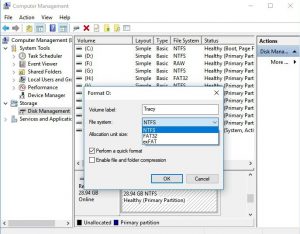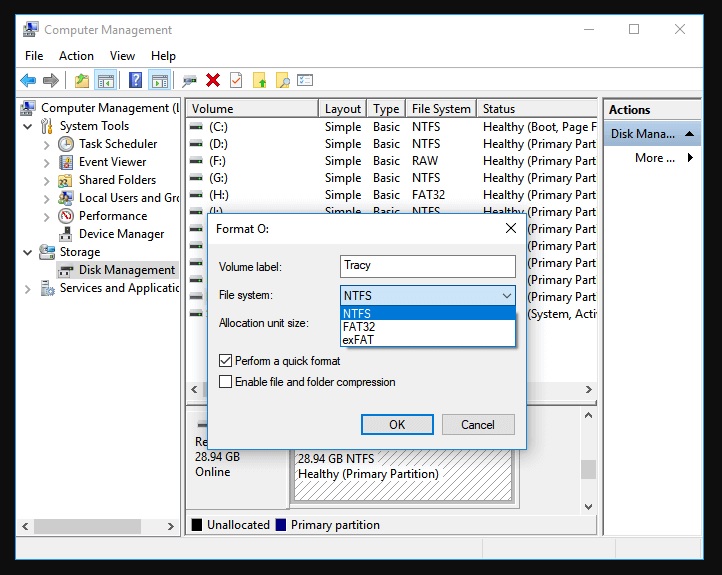What is the Best Format for External Hard Drives?
Have you ever experienced that the hard drive space of your Windows laptop or Macbook Pro is full, and you try to add a new external hard drive by opening the laptop? Many users probably will answer this question with “no.” But the fact is that new laptops use SSD drives that provide limited storage space to the user. At the same time, these drives have a higher price than external or internal hard drives.
Using an external hard drive to store multimedia files is a better option in such a situation. The limited storage space of the laptop’s SSD or external hard drive is better to be free for installing applications and games.

If you have searched a little about external hard drives on the Internet, you have probably come across terms like NTFS, HFS+, FAT32, or exFAT. But what exactly do these words mean?
External hard drives available in the market have different file systems. In this article, you can learn about the formats of external hard drives.
What is the NTFS Format of external hard drives?
If using a Windows computer, the hard drive inside your laptop or desktop computer probably uses the NTFS Format. NTFS is derived from the words “New Technology File System,” which means file system with new technology. Of course, this standard is not very new and was made available for the first time in 1993 and has been improved over the years.
NTFS limits files and partitions that are very large. But don’t worry. This volume is so high that there is no need to worry about it in the coming years. This Format also benefits from additional features such as security permissions for files and folders, internal hard disk links, modification history of a hard disk or a partition, etc.
Compatible with NTFS Format
Although the NTFS file system is natively compatible with the Windows operating system, it does not offer good compatibility with other operating systems.
By default, the Mac operating system can only read files stored on a hard drive formatted with the NTFS file system. Therefore, the user cannot save new information on the hard drive.
Fans of the Linux operating system also only have access to writing on an NTFS format a hard disk in some versions and distributions of Linux.
Sony’s PlayStation 3 and PlayStation 4 consoles do not support the NTFS file system. Even the Xbox 360 game console produced by Microsoft does not use this feature! Of course, Microsoft added support for the NTFS file system in its previous generation console, Xbox One.
In general, the use of this file system is recommended only on Windows computers
What is the HFS+ Format?
As mentioned, computers based on the Mac operating system, by default, only can read information from an external hard drive formatted with the NTFS file system. If you are a Mac OS X operating system user and intend to write new data on your hard disk, you should use a third-party software driver.
If you work entirely in a Mac environment and all your devices are in this ecosystem, it is better to use the HFS+ file system. This file system is derived from the word “Hierarchical File System,” which means hierarchical file system. This Format is also known as Mac OS Extended and HFS Extended.
HFS+ is an improved version of HFS that supports larger files and uses Unicode for naming files. As you know, HFS+ also has the optional feature of logging changes made to an external hard drive or a partition to increase data storage reliability.
HFS+ format compatibility
Although hard drives formatted with the HFS+ file system are compatible with the Mac operating system and computers based on it, the situation is not the same for other operating systems and devices.
Apple exclusively provides this file system. If you connect this hard drive to your Windows computer or laptop, the operating system will not even be able to recognize it. So get rid of the thought of connecting such a hard drive to a device like a game console!
If you use Mac computers and do not need the Windows platform, it is recommended to use the HFS+ file system.
What is the APFS Format?
If using an Apple computer or laptop running macOS High Sierra or later, you can format your external SSD drive or flash drive with the APFS file system.
This file system has high-level features such as strong encryption, shared storage space, fast partitioning, and improved basic features. Note that the APFS file system is only supported in the High Sierra or higher version of the Mac operating system.
If you intend to move data between Mac computers with different macOS versions, the HFS+ file system is probably a better choice.
What is FAT32 Format?
FAT is derived from the “File Allocation Table,” which means file allocation table. Old users of the Windows operating system are well familiar with this file system.
FAT32 was the file system used in the Windows 95 operating system, and in fact, it was introduced as a replacement for FAT16, which is compatible with old and new systems.
In the FAT32 file system, a file must have a maximum size of 4 GB, which seems quite restrictive considering the size of high-quality multimedia files (such as Blu-Ray movies with a size of 20-40 GB!). The FAT32 file system is usually used to transfer files between older systems or compatible devices such as PlayStation 3, Xbox 360, etc.
What is exFAT Format?
Although the name of this file system is more like a slimming drug usually found in their TV commercials, it is the descendant of NTFS and FAT32!
exFAT takes all the good features of FAT32, such as compatibility and ease of use, and leaves behind its major disadvantages, such as the 4GB size limit. On the other hand, the flexibility of NTFS has made it capable of moving very large files and creating large partitions. Of course, the exFAT file system does not have the additional features of NTFS.
exFAT format compatibility
The exFAT file system is a good choice for users who use both Windows and Mac operating systems. Moving files between these two operating systems is a bit of a hassle, so you don’t need to format your hard drive to be compatible with one system each time.
The exFAT file system even supports Linux, so you should use the right software to maximize the maximum potential of drives formatted with the exFAT file system.
The exFAT file system does not inherit all the positive features that FAT32 has in terms of compatibility. These drives are incompatible with older devices such as PlayStation 3 or Xbox 360. But the previous generation game consoles, i.e., PlayStation 4 and Xbox One, have no problems with this file system.
So if you don’t have old game consoles, exFat Format can be the best Format for your external hard drive.
How to reformat an external hard drive
Although, for more convenience, you can buy a hard drive with a file system fully compatible with the operating system you want, most external hard drives on the market offer the ability to reformat or reformat.
If the hard disk is not supplied with the file system you want by default or it is not the best Format for your external hard disk, you can determine the file system of your choice for the hard disk. In the following, we will explain how to do this.
Note: reformatting the hard drive can lead to the loss of all data stored on a hard drive; So, before doing anything, make a backup copy of your data.
How to format external hard drive on Mac
1: Ensure the hard drive is connected to the computer and recognized by the operating system.
2: If you have data saved on your hard disk, copy them to another place right now.
3: In the Finder, select Go and then Utilities. In this way, you enter the /Applications/Utility folder. Instead, you can search for Disk Utility in Spotlight and click on the result that appears.
4: Enter Disk Utility.
5: Click on the icon of your external hard drive in the left side menu.
6: Click on the Erase tab at the top of the window.
7: From the Volume Format menu, select Mac OS Extended.
8: Choose a new name for your external hard drive in the Name box.
9: Click on the Erase button.
How to format an external hard drive in Windows
1: Connect your external hard drive to the computer.
2: If you have information on your hard disk, it is better to copy them to another place.
3: Enter the Windows Explorer environment and find your hard drive by clicking on the Computer section in the side menu.
4: Right-click on the drive and select Format.
5: Select the file system you want in the File System section.
6: Check the Quick Format option.
7: In the Volume Label box, specify a new name for your external hard drive.
8: Click the Start button to format the drive.
9: After the Format is finished, if you intend to remove the hard drive from the computer, be sure to do it as Safely Remove.
Conclusion
In this article, we explained the types of external hard drive formats and tried to help you decide on the best Format for the external hard drive based on the compatibility of each of these formats with Windows and the features they offer.
.

